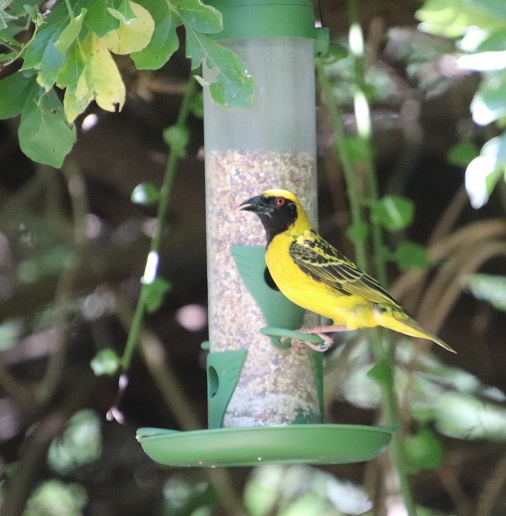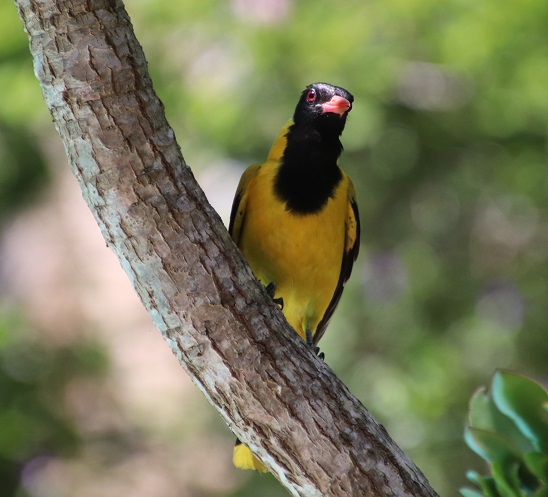November is a month that seems to have sped by. I have been on the road more than usual and we have had inconvenient time slots for power outages – all of which have contributed to the late posting of my monthly overview of the birds visiting our garden. The third of November heralded the blooming of the first Pompon tree flowers and now our garden is brightened with the trees covered in beautiful pink blossoms.
November is also the start of having pesky mosquitoes around and is the time from which I can expect ants, spiders and beetles to land on me from the shady branches I sit under whilst watching birds! The first bird to draw my attention was a Black-eyed (Dark-capped) Bulbul displaying the avian version of panting in the heat – called gular fluttering.
We have experienced temperatures of up to 36°C, so there has been need for all of us to pant a little! Red-eyed Doves are more sensible and generally remain within the shade of the trees and have seldom been seen in the open during the hottest parts of the day. The heat has meant that Cape White-eyes have been visiting the nectar feeder regularly – they have also been enjoying the apples and pears. The Bronze Manikins continue to delight as they fill the feeders with their little bodies.
While the Laughing Doves generally gather in the nearby trees for at least twenty minutes before coming down to feed, there are always a few of them that prefer to filch seed from the feeder rather than joining the masses on the ground. I found the antics of this one particularly amusing.
Southern Masked Weavers have been kept busy feeding their chicks. I enjoy watching them stuff their beaks with fruit to feed their chicks perched nearby. At one point this month the Cape Weavers appeared to be the dominant weaver in the garden. They have now been usurped by Village Weavers.
The Common Fiscals have also been taking food away for their chicks. Meneer still seems to prefer the titbits I offer in my hand rather than helping himself from the dish. While on the subject of feeding, it has been interesting to note that the Black-headed Orioles have shown a definite preference for meat over fruit, which makes me think they too might be feeding chicks hidden somewhere in the dense foliage.
To round off, the Hadeda Ibis chick has made the successful progress from being nest-bound to walking around the garden in the company of one or both parents.
My bird list for this month:
African Green Pigeon
African Hoopoe
Black-collared Barbet
Black Cuckoo-Shrike
Black-eyed (Dark-capped) Bulbul
Black-headed Oriole
Bokmakierie
Bronze Manikin
Burchell’s Coucal
Cape Robin-Chat
Cape Turtle Dove
Cape Weaver
Cape White-eye
Cattle Egret
Common Fiscal
Common Starling
Diederik Cuckoo
Fork-tailed Drongo
Greater Double-collared Sunbird
Green Woodhoopoe
Grey-headed Sparrow
Hadeda Ibis
Klaas’s Cuckoo
Laughing Dove
Lesser-striped Swallow
Olive Thrush
Pin-tailed Whydah
Pied Crow
Red-eyed Dove
Red-throated Wryneck
Red-winged Starling
Southern Boubou
Southern Masked Weaver
Speckled Mousebird
Speckled Pigeon
Village Weaver
White-rumped Swift
Yellow-fronted Canary







Love seeing those birds, so different from ours. What beauties!
LikeLike
Thank you, Laurie. I count my blessings every month to have so many birds around where I live.
LikeLike
How nice of you to share your Pompon scented, bird filled garden. I imagine the feel of that hot sun too!
LikeLike
I am pleased you have enjoyed being here 🙂
LikeLiked by 1 person
I so quickly forget the ‘panting heat’ of summer. 😉 These days the nights are frosty and the days not much warmer, but no snow yet!
It’s nice to be reminded of a bird-filled garden, complete with growing chicks and nestlings. 🙂
LikeLike
I woke up to the sound of rain this morning. It didn’t last long, but how fresh the air is now and it means there is more hope for the garden 🙂
LikeLike
Wonderful!
LikeLike
I feel that you get more birds in a month than we get in a year.
LikeLike
We probably do 🙂
LikeLiked by 1 person
Your observations are sure to be of scientific interest as well, Anne. How long have you been keeping records like this?
LikeLike
Until I began blogging, I used to write interesting observations in various notebooks. My observations have really only become more detailed since I retired.
LikeLiked by 1 person
It would be fascinating to see how the combination of birds in the various months have changed over time, through dry and wet, hot and cold, as the town expanded, and so forth.
LikeLike
It is: there are some birds I don’t see anymore (possibly because our garden is now a mini forest instead of a desert) while others – such as the Knysna Turaco – have moved in. Some seasonal visitors have become year-round ones and there are times when one can expect a brief visit from birds such as the Crowned Hornbills. I usually see a single Red Bishop sometime in December, which is rather fun.
LikeLiked by 1 person
An absolute delight Anne! A wonder-filled list of such variety, xxx
LikeLike
I am fortunate to be able to observe such a variety of birds in our garden – it is a shame that I do not get to photograph them all though 🙂
LikeLiked by 1 person
Your usual impressive collection. I like the filcher shot, too
LikeLike
I am glad you do 🙂
LikeLike
Impressive list Anne!!
LikeLike
Thank you very much, Bondels.
LikeLike
Your Black-headed Orioles look a little like our Goldfinch at first glance. Our Orioles are orange. Funny these names, like the Lantana, make you think they’ll look more similar than they actually are.
LikeLike
You are right. This is where the scientific names are more useful 🙂 🙂
LikeLiked by 1 person
Reblogged this on Wolf's Birding and Bonsai Blog.
LikeLike